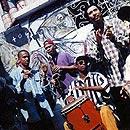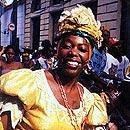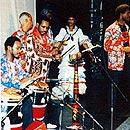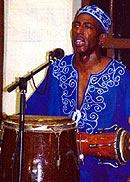Africa in Cuban Music
In Cuba's folkloric music, the resulting synthesis of African and European-Asian antecedents, the former took over as African-origin people became the basic folk layer of our society for centuries.
At the time when Cuban nationality was rising, African-origin people accounted for half the number of islanders who, as a matter of fact, got a hold on the musical trade for quite some centuries. Music was one of the few chances black freedmen had to move up the social ladder during slavery.
“Dark-skinned and brown musicians were the big creators of Cuban folkloric music and responsible of its African roots,” wrote Cuban professor Fernando Ortiz, of the greatest researchers of the Caribbean island's cultural heritage.
All music embraces a social meaning. Society provides the vocals, instruments, pitches, tones, rhythms, melodies, genres and styles, and only in society music finds its human resonance. Black art is a kind of social transference art. African blacks, hailing from a variety of cultural groups, were basically exerting a hefty influence in music and dance, in language and popular imagery.
Out of Western Africa, especially from former Dahomey, Guinea and Ghana, came the Yoruba people from the region of Oyo, as well as the Bantus who made up the largest chunk of a slave population that peaked 50,000 individuals scattered all across the island in 1774. Mr. Ortiz believed that 18th-century Corpus parties were usually complemented by Negro groups that used to walk out the streets with their own garments, chants and dances.
Back in the 18th century, the picture couldn't be any blurrier for folkloric expression. The influence of black ritual music was starting to reach out to ballrooms through the addition of the drum, an object of worship and adoration for some, a heathen and outlawed instrument for others. Either way, it served as the messenger of the gods and the incarnation of the ancestors from Cuba's black religions, people who were usually subjected to kidnappings and knife killings by dyed-in-the-wool and racist authorities.
The fate of the drum has run side by side with the destiny of Negroes who created it. Only Negroes have known how to thump telluric music out of it. Stacked up against the rhythmic sound of African-origin drums, those coming from Spain were undisputedly lesser and only managed to make their way into popular music as soon as they Africanized their percussion in congas and dance parades.
In 1794, a published romance made a description of a certain dance style and the word cotillion showed up for the first time ever. At the time, popular musicians were all the rage. One of them was a humble Havana-born Negro who used to compose light music, cotillions and dances. This stage illustrates the development of a national musical expression. As Negroes started composing cotillions and dances, these two genres found themselves hued by a new shade. Danzon came into being from French cotillion and dances that were usually experimented in Cuba's vernacular theater and born out of the inspiration of hoofers bent on meeting the demand for ballroom dances, urban beats and rural sounds.
Cuba's folkloric heritage comprises an array of integrating elements and shapes ranging from African dregs, Hispanic and Haitian traditions to such completely decanted expressions as son, danzon and rumba (guaguanco, yambu and columbia). This blend lays bare the balanced contribution of those three roots, let alone the lyrical touch purveyed by Italian opera and the vernacular performing arts.
As eastern and Havana's son developed and reached its pinnacle among different semi-professional groups (son bands, quartets, quintets, sextets and septets) with a marked urban beat, rumba, on the other hand, stood for the most genuine expression of popular music that was then blaring out in poor urban neighborhoods, suburban locations (yambu and guaguanco) and rural sites (columbia) in a country with a well-defined nationality of its own.
There's no doubt that rumba, viewed as an artistic fact or occurrence, stemmed from those uncouth barracks where African and Cuban-born slaves used to live crowdedly, and to a lesser extent, from the urban living quarters in Havana's rundown buildings known locally as solares. Columbia rumba also saw the light of day in those same barracks –the dance was named after a location in the province of Matanzas where rumbas or timbas are usually held. Guaguanco, for its part, sprouted up in the few lit corners of Havana's solares. The term guaguanco is more of an onomatopoeic sound whose origin remains buried in darkness. The last member of the pack is the yambu, also of urban origin.
While Yoruba, Bantu and Carabali sounds were ritual and artistic expressions brought from Africa –its people managed to preserve them and even let them exert influence in Catholicism through a profound usage and conceptualization on the part of the Cuban population- rumba and its many variants represent straightforward expressions of the people in their pagan creation.
However, rural-origin Columbia, more primitive and less developed from a melodic and lyric viewpoint- is constantly surfacing certain laments found in Congo chants like Yuca and Macuta sounds, as well as the Mani, easily heard in some locations in the province of Matanzas.
Even though Havana's vernacular theater was the main assimilator of almost all Asian expressions coupled with those created by the people, featuring rumba-like songs and dancing, that breed of the performing arts also contributed to brand that particular artistic creation of the Cuban people under both a concept and presentation somewhat aloof from their original popular profile, especially as far as choreography is concerned.
Rumba, dance and cotillion To date and due to vernacular theater, Cuban and foreign nightclubs, movies, television and commercials have a mistaken concept of what rumba is all about from a musical standpoint. This is the most legitimate folkloric expression of Cuba's musical heritage. A mimicking representation of a rooster chasing a flirting hen that gets excited at the beat of the drums, though she elegantly avoids facing the male dancer, has provided excellent material for vernacular performers on the island nation, as well as rumba showmen in nightclubs and cabarets, TV and movies, to utterly skew an elegant and sharp dance style into an openly sexual match.
This warped creation has even reached fantastic extremes overseas in every sense. Totally unaware of rumba's sound and choreographic outlay, this genre has been picked as the moniker of choice to tag all musical expressions hailing from the island nation. Biased and commercial propaganda wielded by big-time U.S. record labels have splayed the rumba sticker on each and every product made in the Caribbean and the West Indies.
Danzon, Cuba's national dance, harks back to French cotillion. As a result of the Haitian Revolution in the late 18th century, Cuba was invaded by scores of French settlers with their relatives and slave stocks in tow. Most of these newcomers settled down in the eastern provinces, thus giving French cotillion a prominent leg up. Eventually, the rhythm grew roots in the country as the local population put a Cuban spin on it. The first Negroes began then to perform in orchestras, and a decade later rumba's music and choreography were revealing the unmistaken trademark of Cuba's popular quirk.
For roughly thirty years, cotillion was the undisputed king of the ballroom, but it piecemeal gave way to a Cuban dance with identical patterns but marked by an extraordinary melodic, rhythmic and choreographic richness. That first dance laid the foundations of the danzon.
When Matanzas-born musician Miguel Failde introduced his danzon entitled The Simpson Heights on August 12, 1879 in his hometown, he did nothing but add a musical score to a very popular figure dance dubbed precisely danzon. Failde's contribution came about thanks to the insistence of some of his friends and admirers who asked him to write some dance music with a quieter tempo than that of the cotillion and ballroom dance of yesteryear. The different elements chipped in by Failde paved the way for a genre that combined all essential features of the many styles and shapes that formed Cuba's musical melting pot, including Spanish and African experiences.
Guaguanco In the late 19th century and the early 20th century, the famed guaguanco choirs turned up, popularly known as the Paso Franco and Los Roncos from the Pilar and Pueblo Nuevo neighborhoods respectively. These celebrated jam sessions chiefly made up of men and women attached to the Abakuas, Coro de Clave, Pendon de Negros Curros, Cabldo Lucumi and Sociedad de Recreo in their own turfs, unleashed a tense struggle among themselves to show off their musical superiority as far as the beauty and quality of the singing and dancing were concerned. That singing and dancing tug of war dragged on for a few dozen years. The solares' patios and backyards served as perfect makeshift settings for their performances, plus a handful of neighborhood theaters in the nation's capital.
Coro Ronco (Coarse Choir) from Pueblo Nuevo hit it big at the time when it was led by Cuba's great folklorist Ignacio Piñeiro. Other big-time rumba performers made a name of themselves, too. A case in point is Tomas Perez Sanguily, who as a matter of fact was in charge of the band's melodic arrangements and lyrics.
On the other hand, Paso Franco was peppered with a number of talented rumberos whose fame could really hold a candle to such groups as Lugareño and Rapido, just to name but a couple of the most popular bands that garnered many a follower among Havana's guaguanco performers and connoisseurs.






































































